Pan Am Catering Items
End of WW II Through the 1950s
End of WW II Through the 1950s
After WWII Pan Am gave up flying boats for land planes. The first to join the post war fleet were the DC4 and L049 Constellation. These aircraft offered better safety and speed than the flying boats but with smaller passenger cabins. Smaller cabins required Pan Am to rethink dinning service and dinning rooms would not appear again until the 1970s when Pan Am introduced the 747.
With the introduction of land planes Pan Am’s operating costs decreased and founder Juan Trippe lobbied the industry and foreign governments to allow Pan Am to introduce lower fares on many routes. Pan Am was the first international airline to introduce economy class. Pan Am’s economy class was called “The Rainbow.” Customers flew in smaller seats with a 5 across layout instead of the 4 across offered in first class. Below is a picture of a Pan Am DC6 in Rainbow economy configuration. Along with smaller seats “Rainbow” customers had a more modest meal. Below the DC6 photo is a picture of a typical economy meal from the 1950s.
Blue Ribbon Service
Though "The Rainbow" was a big success for Pan Am the company continued to earn most of its revenues from First Class travel which after the war was re-branded “The President.” Though Pan Am offered First Class service aboard the DC4, The Constellation and later the DC6 & DC7 the workhorse of Pan Am’s “blue ribbon” First Class Service was the double deck Boeing 377 “Stratocruiser” introduced in 1949.
The Stratocruiser had spacious “Sleeperette seating and even offered a limited number of berths at an additional cost. The most popular feature of the aircraft was its lower deck lounge. Below are pictures of both the upper and lower deck of the Boeing Stratocruiser.
Below on the left is another picture of the B377 lower deck lounge. This photo shows a steward in a white serving jacket passing a tray of cocktail snacks. The tray is lined with the standard Pan Am linen napkin from the 1950s which can be seen in the photo on the right. Note that the name of Pan Am’s first class service “The President” is embroidered on the upper arm of the steward’s serving jacket.
On certain long flights the passenger entryway of the Boeing Stratocruiser was converted into a buffet area for customers. Below a flight attendant prepares a meal / snack plate for a first class customer.
Breakfast in bed?
Another popular feature of the Stratocruiser was the availability of berths for lay flat sleeping. Berths were offered for approximately $25.00 above the price of the first class fare and were limited.
To the right a flight attendant serves a customer breakfast in bed. Note the tray linen in the flight attendant’s hand was previously seen in the picture of the Stratocruiser lower deck lounge.
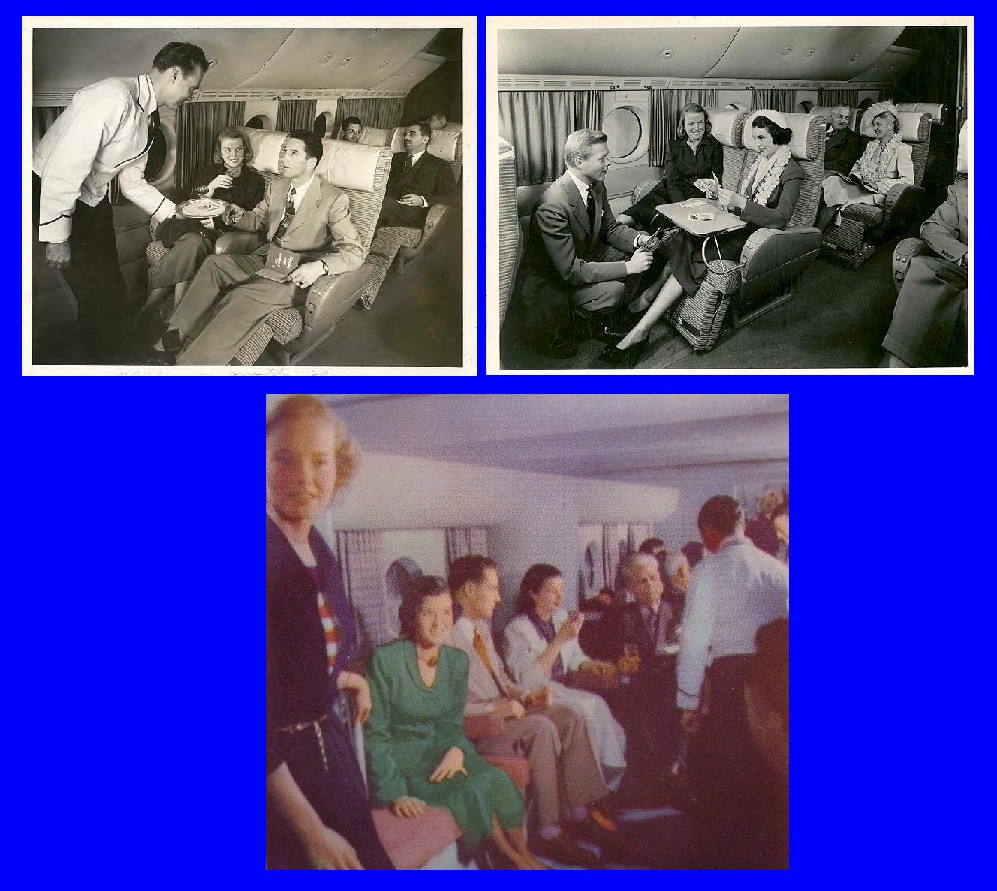
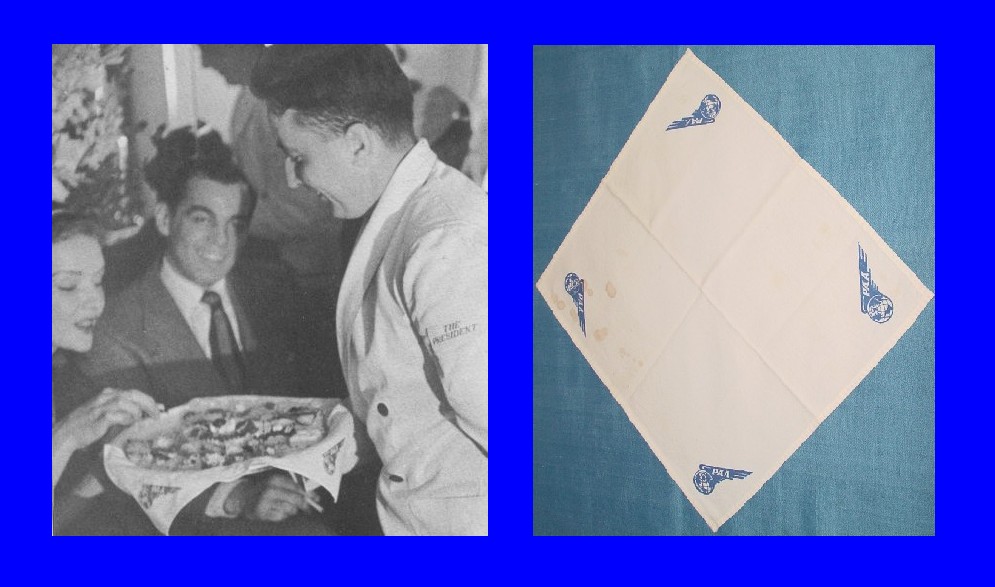
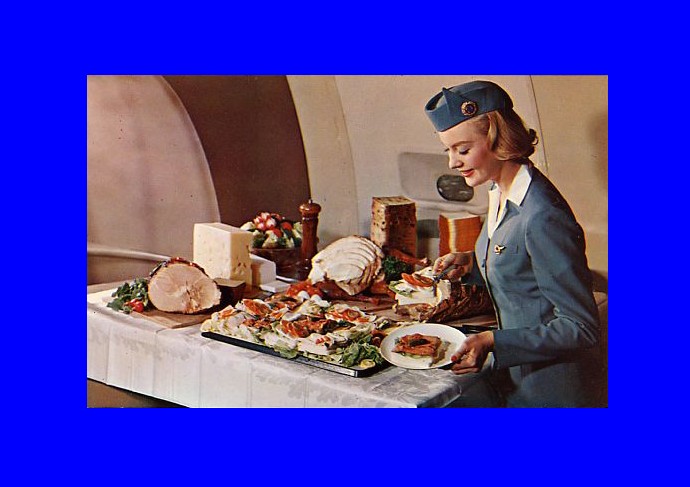
From 1946 through 1957 when not in the lounge, berth or at the buffet table First Class customers were served their meals via “tray set-ups” (meaning everything was presented on one tray – and nothing was served from a cart.
During this time Pan Am operated as three airlines within an airline; Pacific – Alaska Division (headquartered in San Francisco), Latin American Division (headquartered in Miami) and Atlantic Division (headquartered in New York). Each division was responsible for establishing their own catering programs. For this reason there are many different styles of glasses, plates and back stamps on flatware. It was not until the 1960s with the introduction of the “Presidential” china pattern that catering procedures were standardized.
Below is a picture of a typical 1950s tray set-up on a B377 “Stratocruiser.” Below the picture is a sample of the flatware from this era. It is slightly smaller than standard size (knife measures 6 ¾ in length) but is silver plate.
Note the little girl on the small ladder used to access the upper berths offered at an additional charge to first class customers. For those not wishing to pay the surcharge their seat offered a substantial recline and foot rest that Pan Am called a “Sleeperette.”
At some point in the mid 1950s Pan Am used the linen & glasses below as part of the First Class product. I do not know when or for how long these items were used or how many of Pan Am's three divisions (Atlantic, Latin, Pacific)used them. Note the Pan Am wing logo on the left and right edges of the napkin.
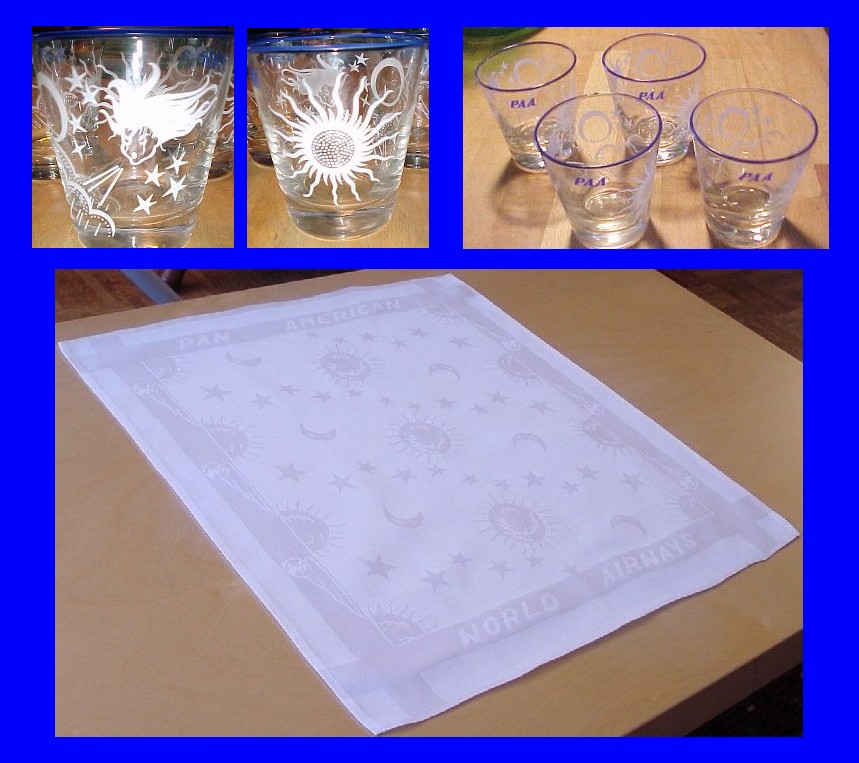
I have been told by crew members that Pan Am first offered “cart service” in 1957 with the introduction (using DC-7 aircraft) of Polar service from the West Coast of the United States to Europe. As flying times were very long with propeller aircraft Pan Am hoped that the cart service would serve as a form of in flight entertainment on the especially long European service from Los Angeles and San Francisco.
Below is a picture of the hors d’oeuvres cart on a Boeing 377 Stratocruiser. Note: the foot rest of the Sleeperette seat and that the upper berth is in the closed position. Information on the china and flatware is given below.
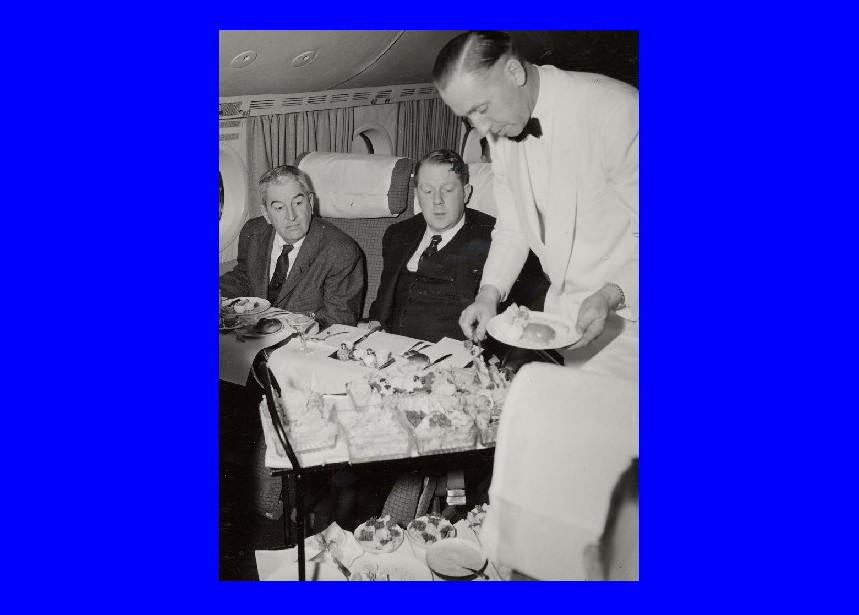
The picture below shows the Rosenthal china patterns used for the “President Special” in the late 1950s. The patterns were part of a larger series created by the famous industrial designer, Raymond Lowey. The Lowey / Rosenthal collection was sold to the public and Pan Am chose to use two patterns in-flight. The idea behind the Lowey design was for the various patterns to mix and match. The white plates with a black circular design are from the “Script” pattern. The black cups and bowls with the white top surface are from the “Charcoal” pattern. Pan Am predominantly used the Script pattern for plates and the Charcoal pattern for accent pieces. Pictured below are the Script dinner plate (center laying flat), salad/dessert plate (center standing) and bread and butter plate (left standing). Also pictured are two size Script bowls; the larger for soup, salad or cereal and the smaller for fruit. Additionally there is a Script standard coffee cup & saucer and demitasse cup (right rear). Finally, there are three Charcoal pieces; standard cup, demitasse cup and a soup, salad or cereal bowl. Pan Am used script saucers with the charcoal cups. Not pictured is the Script demitasse saucer.
The flatware shown was produced by the International Silver Co. and is marked with “PAA” on the bottom at the base of the handle. On some pieces there are an additional three letters; “ATL” for Atlantic Division. To the left of the plate moving inward are a cocktail fork, salad & dessert fork and dinner fork. On the right of the plate moving in are a bread & butter knife and a dinner knife. A soup spoon appears in the charcoal bowl and in front of the demitasse cups are the teaspoon and demitasse spoon (smaller of the two).
Finally, the glassware of this era is displayed. All pieces show the President Special logo (an eagle in flight surrounded by stars). Moving from left to right are the highball, cordial, wine and sherry / martini glasses. A clearer picture of the logo on the glasses is shown further down on this page. For more pictures of this china, flatware and glasses click on the "more pictures" button in the lower right corner of the photo below
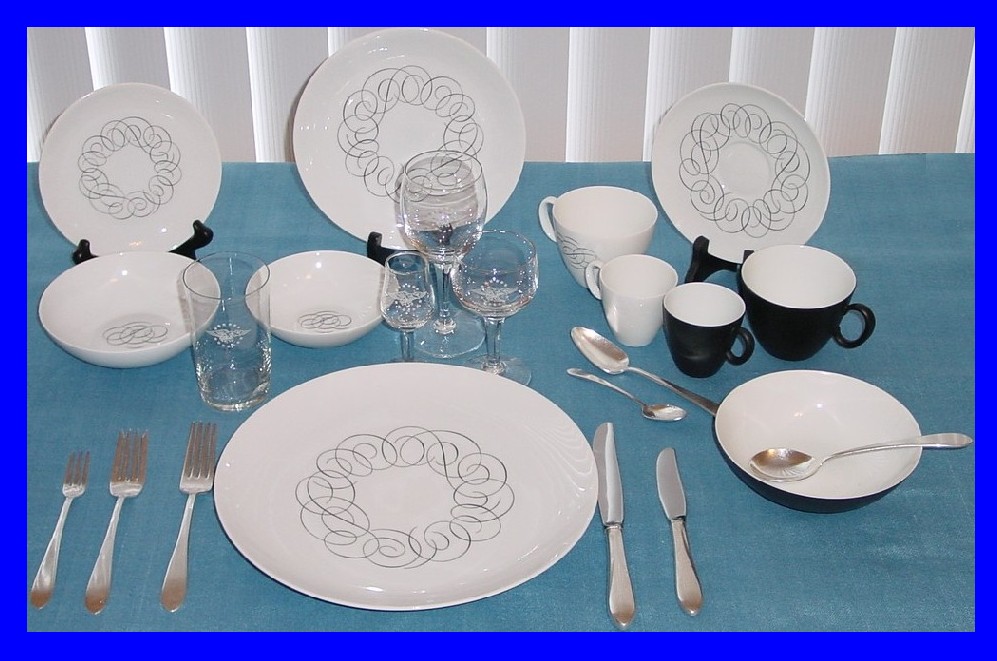
Below are samples of the Script & Charcoal pattern in use. Though all of the below photos are from the early Boeing 707 & DC 8 service the Script & Charcoal pattern were introduced on the Boeing Stratocruiser.
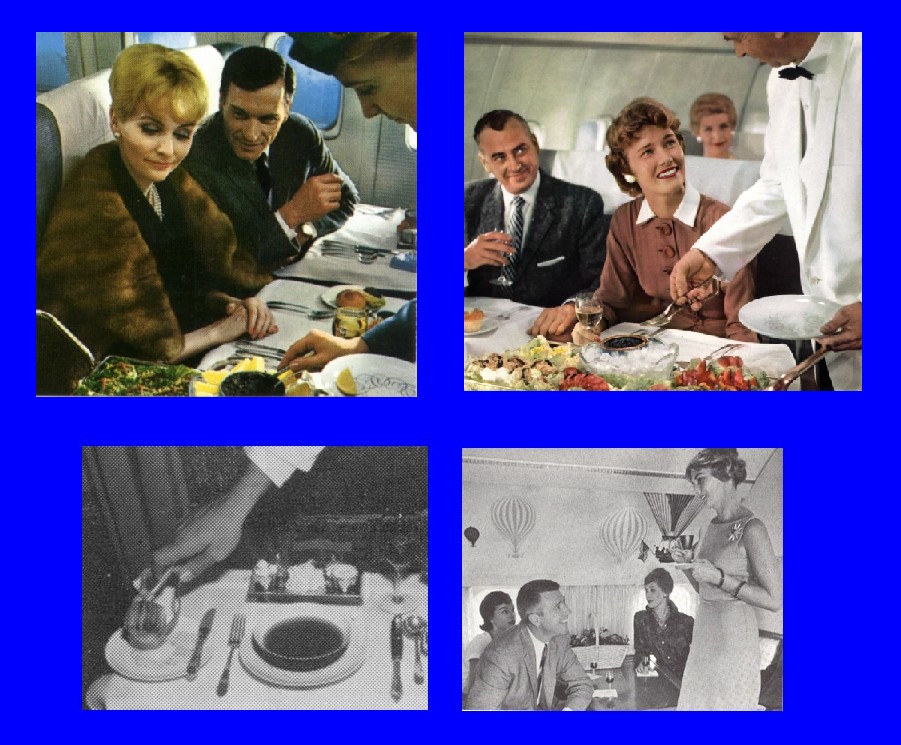
Below on the left is a steward serving a strawberry tart and ice cream on the Script pattern in the early days of the 707 jet service. The ice cream is in a large silver presentation bowl. The style of bowl is seen on the right along with the "back stamp." The bowl measures aproximately 5 3/4 inches tall with a diameter of aproximately 10 inches. Observe that this particular style of bowl has a protruding rim at the top.
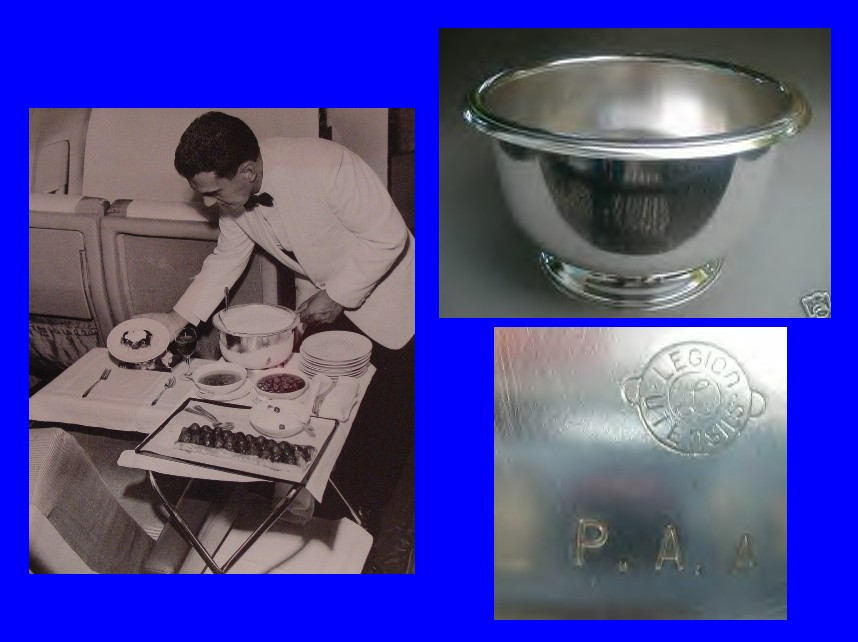
The silver presentation bowl came in several different styles, sizes and finishes. The photo below shows identically sized silver bowls without lips in two different finishes. Both bowls were manufactured by the International Silver Company. They measure 4 3/4 inches tall with a diameter of 8 1/2 inches. Further down in this review will be an example of the smaller sized presentation bowl.
In the photo below this is a silver condiment ring also bearing “PAA” markings. The condiment ring is fitted for the bowl and was often used for the caviar service where chopped egg and onion were offered with the caviar. The condiment ring was also produced by the International Silver Co.
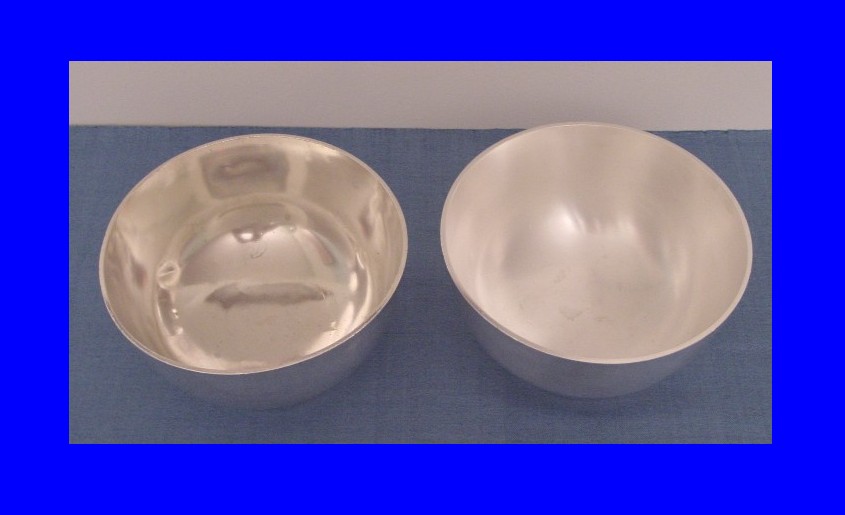
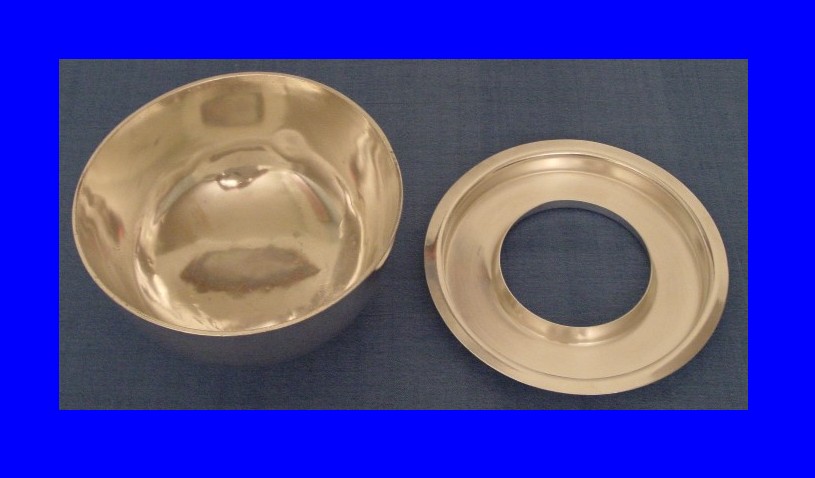
Below are two types of pitchers used in-flight in the 1950s. On top is a silver plate pitcher standing just short of 6 inches tall. There is no manufacturer indicated. Below this is a stainless steel pitcher with "PAA" side markings manufactured by Vollrath.
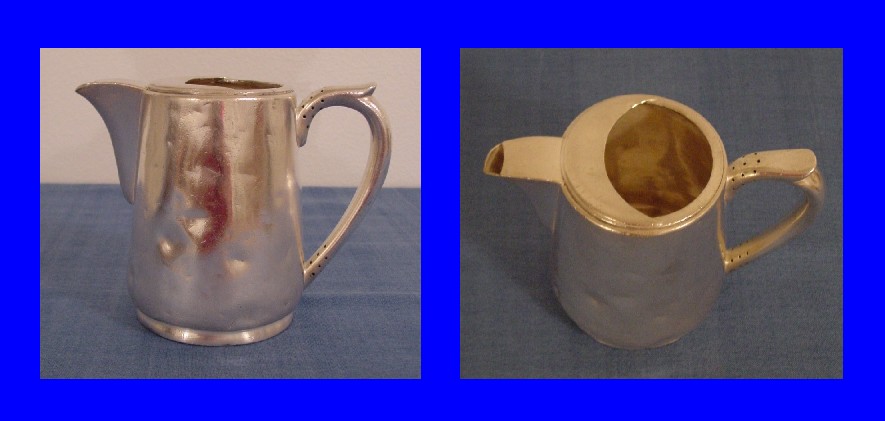
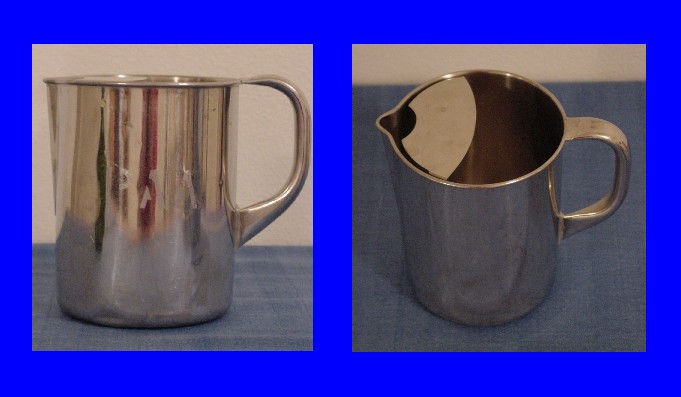
The glasses below on the left are from the 1950s with six stars above the eagle. The glasses on the right are from the 1960s with a differnt style of eagle and only three stars above.
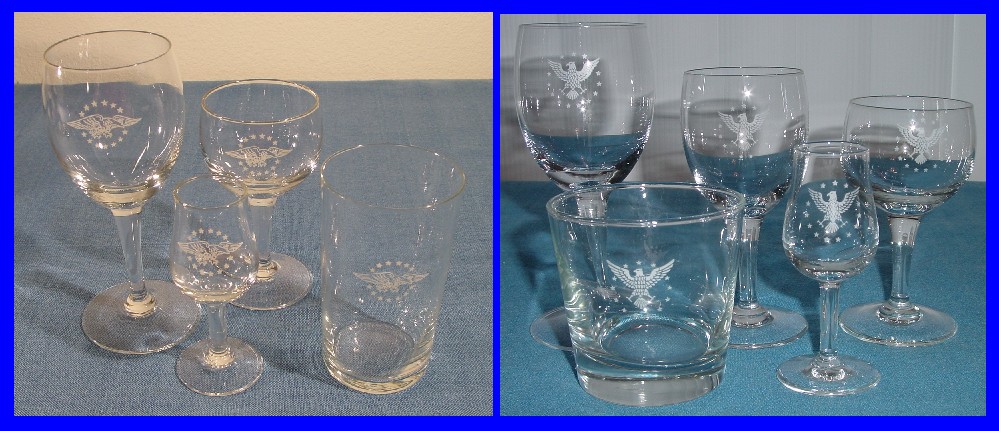
Below is an image of the First Class Lounge on a Boeing 707 located in the front of the passenger cabin. You can almost see the "6 star" glass in the hand of the man in the lower right.
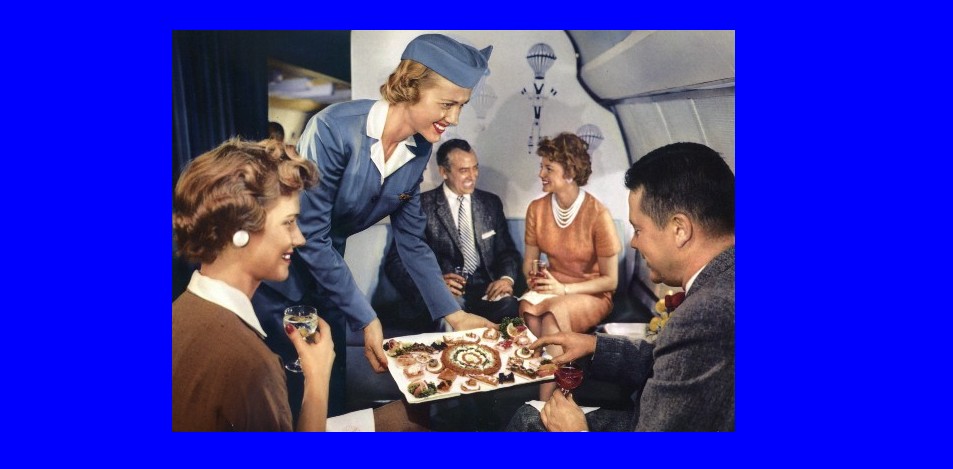
Below on the left is a photo of a flight attendant serving cocktails from a long neck silver pitcher in the First Class lounge of the 707. To the right is an example of the pitcher.
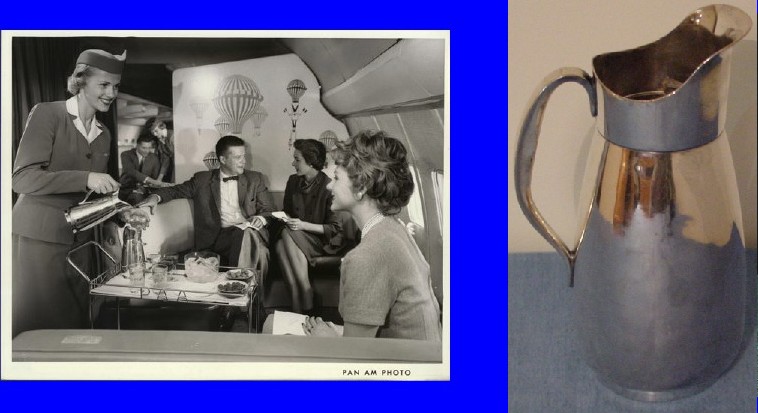
The stainless steal coffee pot with black wooden handle below is the last item from the 1950s. Other than the "PAA" markings there is no manufacturer stamped on the bottom.
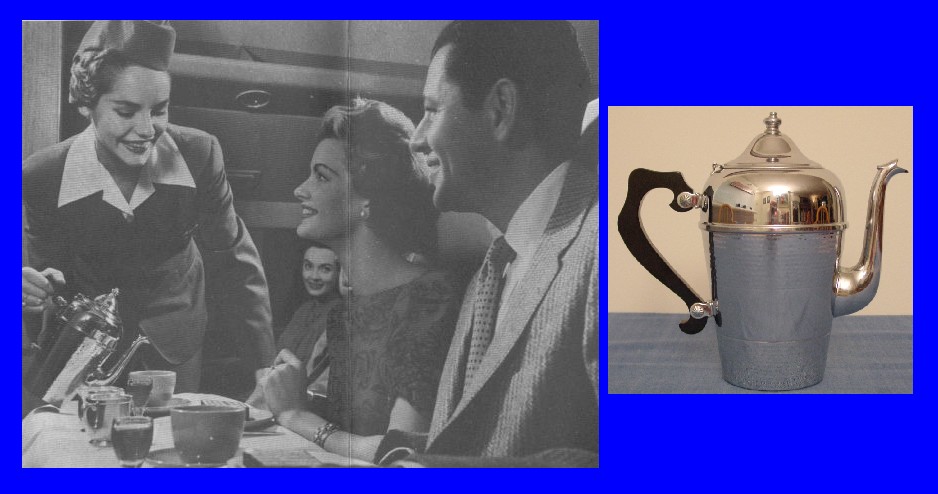
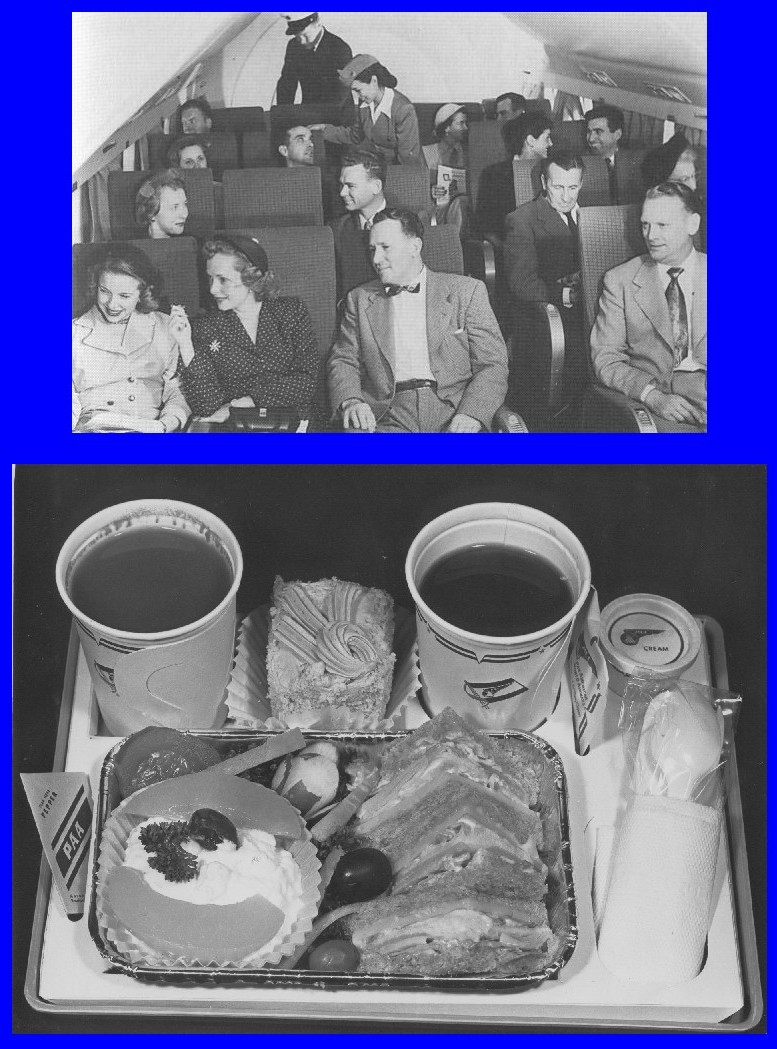
Rainbow Service
With faster, more efficient, land planes Pan Am lobbied the International Air Transport Association to begin offering lower fares at reduced service levels. This concept became known as "tourist" service and is today known as "economy" or "coach."
In 1952 Pan Am succeeded in getting the authorizations to begin "tourist" service. Pan Am named its tourist service "The Rainbow." To the right is a picture of the 5 abreast "Rainbow" seating on a DC6.
Rainbow Meals
As part of the qualification for offering a "tourist" product the airlines all had to agree on how the in-flight amenities would be differ from First Class. One of the requirements was cold meals only. To the right is a Pan Am "Rainbow" meal from the 1950s.
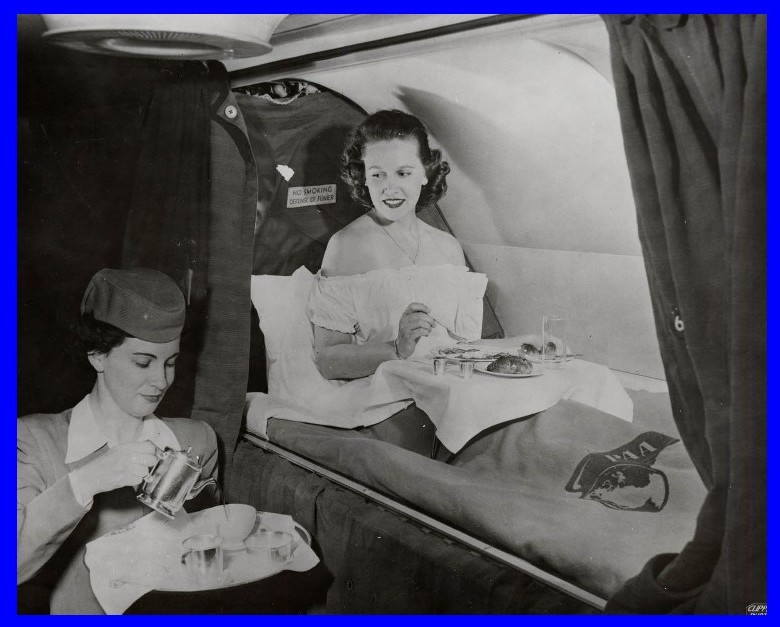
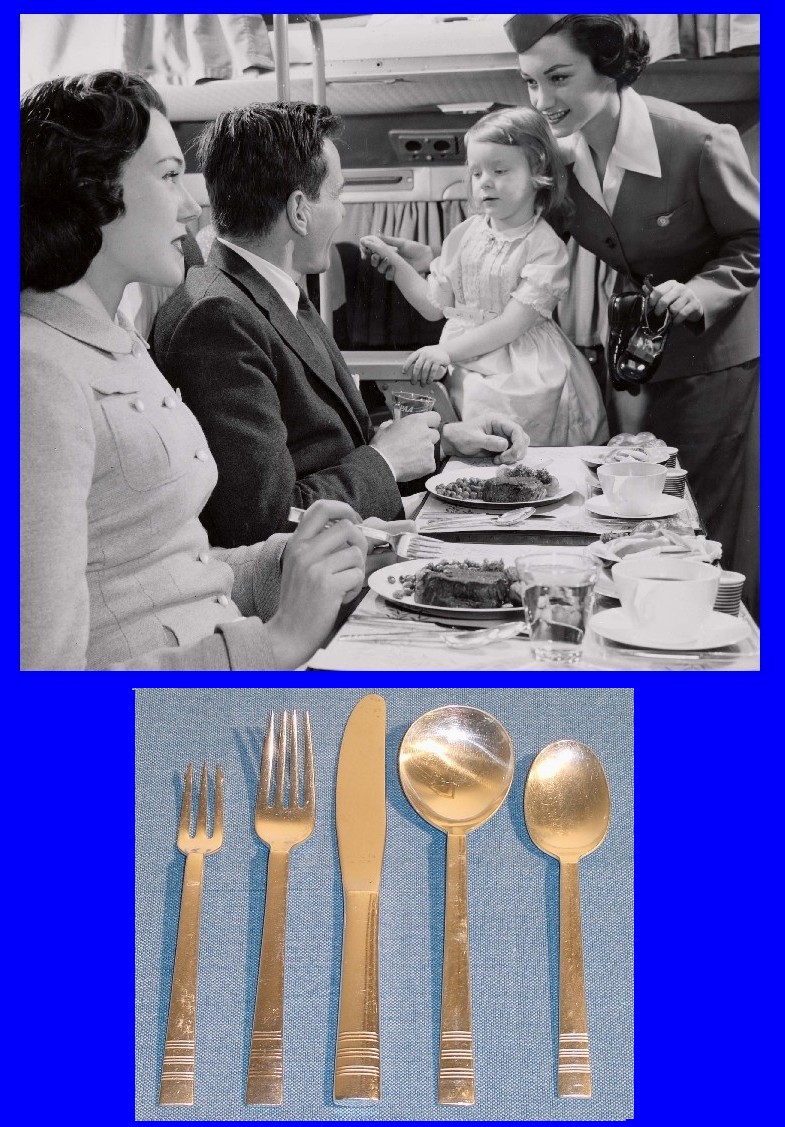
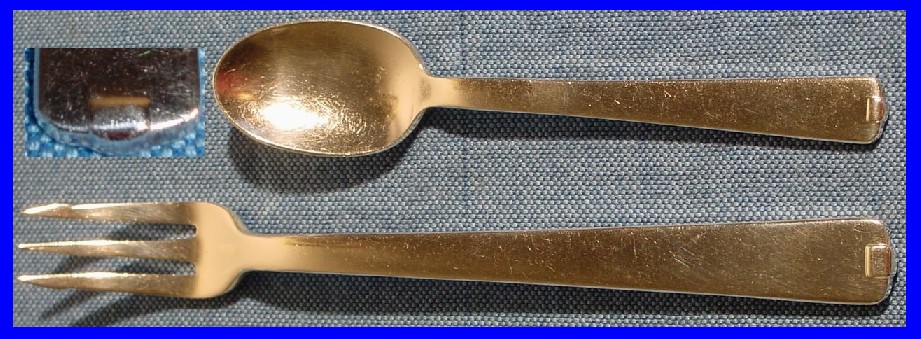
Below are another style of Pan Am silver plate flatware. It is back stamped "PAA LAD" which means Pan American Airways Latin America Division. Most likely this flatware dates from the late 1940s to early 1950s.
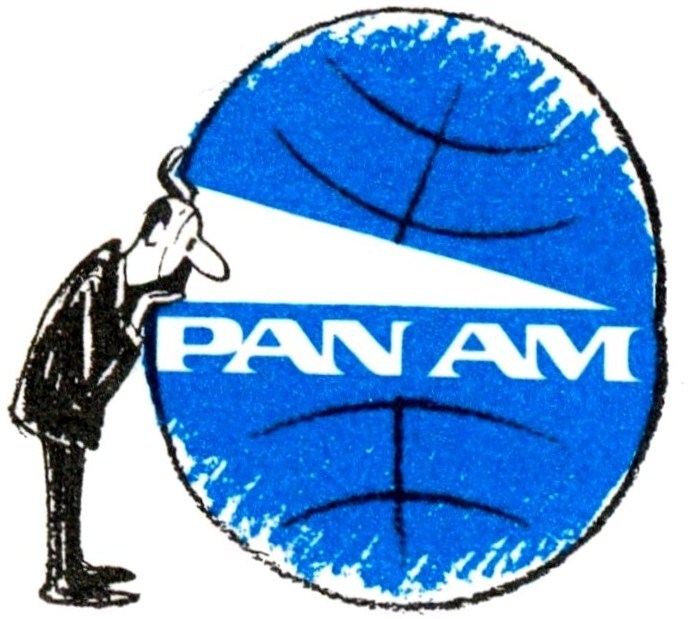
everythingPanAm.com
The Virtual Pan Am Museum